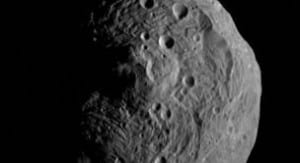
 Dawn Spacecraft Returns Close-Up Image of Asteroid Vesta
Dawn Spacecraft Returns Close-Up Image of Asteroid Vesta
NASA’s Dawn spacecraft has returned the first close-up image after beginning its orbit around the giant asteroid Vesta. On Friday, July 15, Dawn became the first probe to enter orbit around an object in the main asteroid belt, which lies between the orbits of Mars and Jupiter.
The image shows Vesta in greater detail than ever before. When Vesta captured Dawn into its orbit, there were approximately 9,900 miles between the spacecraft and asteroid.
Vesta is 330 miles in diameter and the second most massive object in the asteroid belt. Ground- and space-based telescopes have obtained images of Vesta for about two centuries, but they have not been able to see much detail on its surface.
“We are beginning the study of arguably the oldest primordial surface in the solar system,” said Dawn principal investigator Christopher Russell of UCLA. “This region of space has been ignored for far too long. The images received to date reveal a complex surface that seems to have preserved some of the earliest events in Vesta’s history, as well as logging the onslaught that Vesta has suffered in the intervening eons.”
Vesta is thought to be the source of a large number of meteorites that fall to Earth. Vesta and its new NASA neighbor are currently approximately 117 million miles away from Earth. The Dawn team will begin gathering science data in August.
After traveling nearly four years and 1.7 billion miles, Dawn also accomplished the largest propulsive acceleration of any spacecraft, with a change in velocity of more than 4.2 miles per second, due to its ion engines. The engines expel ions to create thrust and provide higher spacecraft speeds than any other technology currently available.
Engineers have been subtly shaping Dawn’s trajectory for years to match Vesta’s orbital speed around the Sun. Unlike other missions, where dramatic propulsive burns put spacecraft into orbit around a planet, Dawn simply eased up next to Vesta. Then the asteroid’s gravity captured the spacecraft into orbit.
“Dawn slipped gently into orbit with the same grace it has displayed during its years of ion thrusting through interplanetary space,” said Marc Rayman, Dawn chief engineer and mission manager at JPL. “It is fantastically exciting that we will begin providing humankind its first detailed views of one of the last unexplored worlds in the inner solar system.”
Although orbit capture is complete, the approach phase will continue for about three weeks. During approach the Dawn team will continue a search for possible moons around the asteroid; obtain more images for navigation; observe Vesta’s physical properties; and obtain calibration data. In addition, navigators will measure the strength of Vesta’s gravitational tug on the spacecraft to more accurately compute the asteroid’s mass.
Dawn will spend one year orbiting Vesta, then leave in July 2012 to travel on to a second destination, the dwarf planet Ceres, arriving there in February 2015.
UCLA is responsible for Dawn mission science. Orbital Sciences Corp. of Dulles, Va., designed and built the spacecraft. The German Aerospace Center, the Max Planck Institute for Solar System Research, the Italian Space Agency and the Italian National Astrophysical Institute are part of the mission’s team.
You can contact Bob Eklund at [email protected], or visit his websites at www.bobeklund.com and http://firststarbook.com.


Wow – amazing… almost 2 billion miles propeled by “ions”. That form of propulsion must only work in a vacuum? I’ll have to look it up! Thanks for the article.